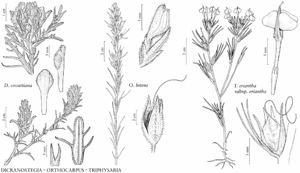Orthocarpus luteus
Gen. N. Amer. Pl. 2: 57. 1818.
Annuals 10–40 (–60) cm. Stems erect to ascending, pubescent and pilose. Leaves 15–50 mm; blade: proximal margins entire, distal entire or 3-lobed. Inflorescences spikes, (2–) 5–20 cm; bracts 10–20 mm, margins 3-lobed in distal 1/2, proximal resembling distal leaves, midlobe green distally, triangular, 2–3 mm wide, apex acuminate, not cuspidate, lateral lobes narrowly lanceolate. Pedicels 0 mm. Flowers: calyx 5–8 mm; corolla 10–15 mm, longer than bracts, abaxial lip inflated, lobes 3, rounded, adaxial lip golden yellow, 2–4 mm, equal to abaxial, glandular-puberulent, tip minutely hooked, not bearded. Capsules 5–7 mm, apex retuse. Seeds 20–35, yellow or dark-brown, ovoid, 1.2–1.5 mm, reticulate, longitudinally ridged. 2n = 28.
Phenology: Flowering Jun–Sep.
Habitat: Grasslands, sagebrush scrub, mountain meadows, disturbed grounds.
Elevation: (200–)400–3000 m.
Distribution
Alta., B.C., Man., Ont., Sask., Ariz., Calif., Colo., Idaho, Minn., Mont., Nebr., Nev., N.Mex., N.Dak., Oreg., S.Dak., Utah, Wash., Wyo.
Discussion
Orthocarpus luteus can be distinguished by its golden yellow corollas, with minutely hooked tips on adaxial lips. The Ontario population is not native. The Blackfeet used the leaves of O. luteus to dye skins, hair, and feathers red to reddish brown (A. Johnston 1987).
Selected References
None.
